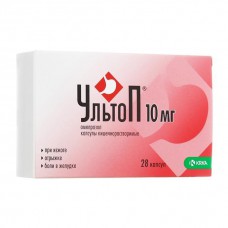Expiration date: 02/2026
Composition and form of release:
Capsules. 1 capsule contains:
omeprazole 10, 20 or 40 mg
excipients: sugar granules (sucrose, corn starch) hyprolose magnesium carbonate heavy sucrose corn starch sodium lauryl sulfate
pellet shell: methacrylic acid and ethacrylate copolymer (1:1) talc* macrogol 6000 titanium dioxide sodium hydroxide
capsule shell composition:
capsule body: iron oxide red (E172) titanium dioxide (E171) gelatin dye
capsule cap: iron dye red oxide (E172) titanium dioxide (E171) gelatin, *0, 2% talc (calculated by weight of pellets/capsule — mixed with pellets before placing them in capsules to reduce the electrostatic charge during capsule filling)
7 caps. in a blister of 14 or 28 caps. the PE canisters with screwed polypropylene cap with tamper-evident and capsule hydrosorbent 2 or 4 blisters in the cardboard pack together with the instruction for use or 1 case in cardboard pack together with the instruction manual. An additional capsule of hydrosorbent is enclosed in a PE pencil case of 28 caps. (for a dosage of 40 mg).
7 caps each. in a contour cell package (blister), 2 or 4 contour cell packages (blisters) in a pack of cardboard together with instructions for use.
Description of the dosage form:
10 mg capsules: two — color, the capsule body is light pink, the lid is white.
20 mg capsules: two — color, the capsule body is light pink, the lid is brown-pink.
40 mg capsules: two — color, the capsule body is brown-pink, the lid is light pink.
Capsules of 10 and 40 mg — contain pellets from white to white with a yellowish or pinkish tinge of color.
Capsules of 20 mg — contain pellets from white to white with a yellowish or pinkish tinge of color.
Pharmacokinetics:
Omeprazole is rapidly absorbed from the gastrointestinal tract, Cmax in plasma is reached after 0, 5-1 hours.Bioavailability is 30-40%. Binding to plasma proteins is about 90%. Omeprazole is almost completely metabolized in the liver. It is an inhibitor of the enzyme system CYP2C19. T1/2 — 0, 5-1 h. Excretion by the kidneys — 70-80% and with bile — 20-30%. In chronic renal failure, excretion decreases in proportion to the decrease in creatinine clearance. In elderly patients, excretion decreases and bioavailability increases. In hepatic insufficiency, bioavailability is 100%, T1/2 — 3 hours.
Description of pharmacological action:
Inhibits the enzyme H+-K+-ATPase (proton pump) in the parietal cells of the stomach and thereby blocks the final stage of hydrochloric acid synthesis. This leads to a decrease in basal and stimulated secretion, regardless of the nature of the stimulus. After a single oral administration of the drug, the effect of omeprazole occurs within the first hour and lasts for 24 hours, the maximum effect is achieved after 2 hours.
In patients with duodenal ulcer, 20 mg of omeprazole maintains an intragastric pH of 3 for 17 hours. After discontinuation of the drug, secretory activity is fully restored in 3-5 days.
Indications:
- peptic ulcer of the stomach and duodenum (acute phase and anti-relapse treatment), including those associated with Helicobacter pylori (as part of combination therapy)
- gastroesophageal reflux disease (GERD), including reflux esophagitis and non-erosive forms of reflux disease (GERD)
- erosive and ulcerative lesions of the stomach and duodenum associated with NSAIDs, stress ulcers
- Zollinger-Ellison syndrome and other pathological conditions associated with increased gastric secretion.
Contraindications:
- hypersensitivity to omeprazole or other components of the drug
- children's age
- pregnancy
- lactation period.
With caution — kidney and/or liver failure.
Use during pregnancy and lactation:
The safety of use during pregnancy and lactation (breast-feeding) has not been studied. Therefore, it is not recommended to prescribe during pregnancy. If necessary, the appointment during lactation should stop breastfeeding.
Side effect:
In rare cases, the following, usually reversible, adverse reactions may occur.
From the digestive system: diarrhea or constipation, nausea, vomiting, flatulence, abdominal pain, dry mouth, taste disorders, stomatitis, transient increase in the activity of liver enzymes in plasma in patients with previous severe liver disease — hepatitis (including jaundice), liver function disorders.
From the nervous system: headache, dizziness, agitation, drowsiness, insomnia, paresthesia, depression, hallucinations in patients with severe concomitant somatic diseases, patients with previous severe liver disease — encephalopathy.
From the musculoskeletal system: muscle weakness, myalgia, arthralgia.
From the hematopoietic system: leukopenia, thrombocytopenia in some cases — agranulocytosis, pancytopenia.
From the skin: itching, skin rash in some cases — photosensitization, multiform exudative erythema, alopecia.
Allergic reactions: urticaria, angioedema, bronchospasm, interstitial nephritis, anaphylactic shock, fever.
Other: visual impairment, peripheral edema, increased sweating, gynecomastia rarely — the formation of gastric glandular cysts during long-term treatment (a consequence of inhibition of hydrochloric acid secretion, is benign, reversible).
Drug interaction:
Long-term use of omeprazole at a dose of 20 mg once a day in combination with caffeine, theophylline, piroxicam, diclofenac, naproxen, metoprolol, propranolol, ethanol, cyclosporine, lidocaine, quinidine and estradiol did not lead to changes in their plasma concentrations.
There was no interaction with simultaneously taken antacids.
It can reduce the absorption of ampicillin esters, iron salts, Itraconazole and ketoconazole (omeprazole increases the pH of the stomach).
As an inhibitor of cytochrome P450, it can increase the concentration and reduce the excretion of diazepam, indirect anticoagulants, and phenytoin, which in some cases may require reducing the doses of these drugs.
When taken simultaneously with clarithromycin, blood concentrations of omeprazole and clarithromycin increase.
Dosage and administration:
Inside, before eating, with a small amount of water (the contents of the capsule can not be chewed).
Duodenal ulcer in the acute phase — 20 mg/day for 2-4 weeks (in resistant cases — up to 40 mg/day).
Gastric ulcer in the acute phase and erosive-ulcerative esophagitis — 20-40 mg/day for 4-8 weeks.
Gastroesophageal reflux disease (GERD): patients with moderate inflammation — 1 capsule (20 mg) once a day in the morning, before Breakfast, for 4-8 weeks. To ensure the following dosage regimen, you can take the drug in a different registered dosage (Ultop capsules 40 mg). Patients with severe GERD resistant to conventional therapy — 40 mg once a day, before Breakfast. The duration of the main course is usually 4-8 weeks. After healing of erosive esophagitis, maintenance treatment is indicated for 26-52 weeks, with severe esophagitis — for life.
Erosive and ulcerative lesions of the gastrointestinal tract caused by NSAIDs — 20 mg/day for 4-8 weeks.
Eradication of Helicobacter pylori — 20 mg 2 times a day for 7 or 14 days (depending on the treatment regimen used) in combination with antibacterial agents.
Anti — relapse treatment of gastric and duodenal ulcer-10-20 mg/day.
Anti-relapse treatment of reflux esophagitis — 20 mg/day for a long time. Reception is possible on demand.
Zollinger-Ellison syndrome — the dose is selected individually depending on the initial level of gastric secretion, usually starting from 60 mg/day. If necessary, the dose is increased to 80-120 mg/day, in this case it is divided into 2 doses.
In patients with severe hepatic insufficiency, the daily dose should not exceed 20 mg.
Overdose:
Symptoms: visual impairment, drowsiness, agitation, confusion, headache, increased sweating, dry mouth, nausea, arrhythmia.
There is no specific antidote.
Treatment: symptomatic.
Special instruction:
Before starting therapy, it is necessary to exclude the presence of a malignant process (especially with stomach ulcers), because treatment, masking the symptoms, can delay the correct diagnosis.
In special cases, if you have difficulty swallowing the whole capsule, you can swallow its contents after opening or resorbing the capsule, and you can also mix the contents of the capsule with a slightly acidified liquid (juice, yogurt) and use the resulting suspension for 30 minutes.
In normal dosages, the drug does not affect the speed of psychomotor reactions and concentration.





